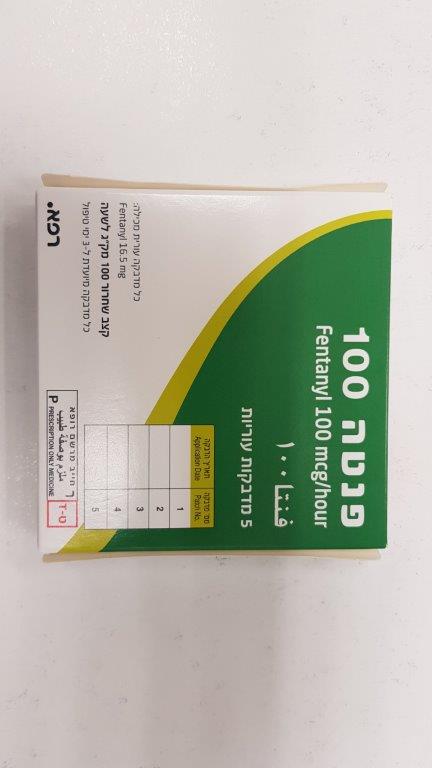Quest for the right Drug

פנטה 100 FENTA 100 (FENTANYL)
תרופה במרשם
תרופה בסל
נרקוטיקה
ציטוטוקסיקה
צורת מתן:
בין-עורי : TRANSDERMAL
צורת מינון:
מדבקות : PATCHES
עלון לרופא
מינוניםPosology התוויות
Indications תופעות לוואי
Adverse reactions התוויות נגד
Contraindications אינטראקציות
Interactions מינון יתר
Overdose הריון/הנקה
Pregnancy & Lactation אוכלוסיות מיוחדות
Special populations תכונות פרמקולוגיות
Pharmacological properties מידע רוקחי
Pharmaceutical particulars אזהרת שימוש
Special Warning עלון לרופא
Physicians Leaflet
Adverse reactions : תופעות לוואי
4.8 Undesirable effects The safety of fentanyl transdermal patch was evaluated in 1,565 adult and 289 paediatric subjects who participated in 11 clinical studies (1 double-blind, placebo-controlled; 7 open-label, active-controlled; 3 open-label, uncontrolled) used for the management of chronic malignant or non-malignant pain. These subjects received at least one dose of fentanyl transdermal patch and provided safety data. Based on pooled safety data from these clinical studies, the most commonly reported (i.e. ≥10% incidence) adverse reactions were: nausea (35.7%), vomiting (23.2%), constipation (23.1%), somnolence (15.0%), dizziness (13.1%), and headache (11.8%). The adverse reactions reported with the use of fentanyl transdermal patch from these clinical studies including the above-mentioned adverse reactions, and from post-marketing experiences are listed below in Table 5. The displayed frequency categories use the following convention: very common (≥1/10); common (≥1/100 to <1/10); uncommon (≥1/1,000 to <1/100); rare (≥1/10,000 to <1/1,000); very rare (<1/10,000); not known (cannot be estimated from the available clinical data). The adverse reactions are presented by System Organ Class and in order of decreasing seriousness within each frequency category. Table 5: Adverse reactions in adult and paediatric patients System/organ class Frequency category Very common Common Uncommon Rare Not known Immune system Hypersensitivity Anaphylactic disorders shock, Anaphylactic reaction, Anaphylactoid reaction Endocrine Androgen disorders deficiency Metabolism and Anorexia nutrition disorders Psychiatric Insomnia, Agitation, Delirium disorders Depression, Disorientation, Anxiety, Euphoric mood Confusional state, Hallucination Nervous system Somnolence, Tremor, Hypoaesthesia, disorders Dizziness, Paraesthesia Convulsion (including Headache clonic convulsions and grand mal convulsion), Amnesia, Depressed level of consciousness, Loss of consciousness Eye disorders Vision blurred Miosis Ear and labyrinth Vertigo disorders Cardiac disorders Palpitations, Bradycardia, Tachycardia Cyanosis Vascular disorders Hypertension Hypotension Respiratory, Dyspnoea Respiratory Apnoea, Bradypnoea thoracic and depression, Hypoventilation mediastinal Respiratory distress disorders Gastrointestinal Nausea, Diarrhoea, Dry Ileus Subileus disorders Vomiting, mouth, Abdominal Constipation pain, Abdominal pain upper, Dyspepsia Skin and Hyperhidrosis, Eczema, Dermatitis subcutaneous Pruritus, Rash, allergic, Skin tissue disorders Erythema disorder, Dermatitis, Dermatitis contact Musculoskeletal Muscle spasms Muscle twitching and connective tissue disorders Renal and urinary Urinary retention disorders Reproductive Erectile dysfunction, system and breast Sexual dysfunction disorders General disorders Fatigue, Oedema Application site Application site and administration peripheral, reaction, Influenza- dermatitis, site conditions Asthenia, like illness, Feeling of Application site Malaise, Feeling body temperature eczema cold change, Application site hypersensitivity, Drug withdrawal syndrome, Pyrexia* * The assigned frequency (uncommon) is based on analyses of incidence including only adult and paediatric clinical study subjects with non-cancer pain. Paediatric population The safety of fentanyl transdermal patch was evaluated in 289 paediatric subjects (<18 years) who participated in 3 clinical studies for the management of chronic or continuous pain of malignant or non-malignant origin. These subjects received at least one dose of fentanyl transdermal patch and provided safety data (see section 5.1). The safety profile in children and adolescents treated with fentanyl transdermal patch was similar to that observed in adults. No risk was identified in the paediatric population beyond that expected with the use of opioids for the relief of pain associated with serious illness and there does not appear to be any paediatric-specific risk associated with fentanyl transdermal patch use in children as young as 2 years old when used as directed. Based on pooled safety data from these 3 clinical studies in paediatric subjects, the most commonly reported (i.e. ≥10% incidence) adverse reactions were vomiting (33.9%), nausea (23.5%), headache (16.3%), constipation (13.5%), diarrhoea (12.8%), and pruritus (12.8%). Tolerance, physical dependence, and psychological dependence can develop on repeated use of Fenta TDP (see section 4.4). Opioid withdrawal symptoms (such as nausea, vomiting, diarrhoea, anxiety, and shivering) are possible in some patients after conversion from their previous opioid analgesic to Fenta TDP or if therapy is stopped suddenly (see sections 4.2 and 4.4). There have been very rare reports of newborn infants experiencing neonatal withdrawal syndrome when mothers chronically used fentanyl transdermal patch during pregnancy (see section 4.6). Cases of serotonin syndrome have been reported when fentanyl was administered concomitantly with highly serotonergic drugs (see sections 4.4. and 4.5). Reporting of suspected adverse reactions Reporting suspected adverse reactions after authorisation of the medicinal product is important. It allows continued monitoring of the benefit/risk balance of the medicinal product. Any suspected adverse events should be reported to the Ministry of Health according to the National Regulation by using an online form https://sideeffects.health.gov.il/

שימוש לפי פנקס קופ''ח כללית 1994
לא צוין
תאריך הכללה מקורי בסל
01/01/2000
הגבלות
תרופה מוגבלת לרישום ע'י רופא מומחה או הגבלה אחרת
מידע נוסף
עלון מידע לצרכן
07.08.22 - עלון לצרכן אנגלית 07.08.22 - עלון לצרכן עברית 07.08.22 - עלון לצרכן ערבית 04.01.23 - עלון לצרכן עברית 06.03.23 - עלון לצרכן אנגלית 06.03.23 - עלון לצרכן עברית 06.03.23 - עלון לצרכן ערבית 16.08.23 - עלון לצרכן אנגלית 16.08.23 - עלון לצרכן עברית 16.08.23 - עלון לצרכן ערבית 23.05.19 - החמרה לעלון 13.06.19 - החמרה לעלון 28.02.22 - החמרה לעלון 18.01.15 - החמרה לעלון 04.01.23 - החמרה לעלוןלתרופה במאגר משרד הבריאות
פנטה 100